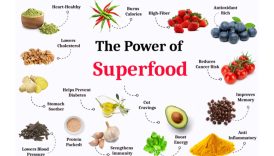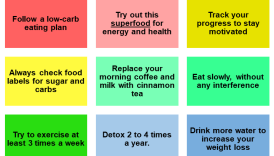From Couch Potato to Fitness Fanatic: A Journey to Better Health

Introduction to a Healthier Lifestyle
Recognizing the Need for Change
In today’s fast-paced world, many individuals find themselves caught up in unhealthy habits, often neglecting their physical and mental well-being. Recognizing the need for change is the first crucial step towards adopting a healthier lifestyle. It’s important to take a moment to reflect on personal habits and their impact. For instance, consider Sarah, who realized that her energy levels were dwindling after months of office work combined with fast food lunches. One day while attempting to climb a flight of stairs, she felt fatigued and out of breath, prompting her to question her lifestyle choices. Moments like these are pivotal; they highlight the disconnect between how one feels and how one treats their body. A few signs that it’s time for a change may include:
- From Couch Potato to Fitness Fanatic: A Journey to Better Health
- Introduction to a Healthier Lifestyle
- Recognizing the Need for Change
- Setting Realistic Fitness Goals
- Creating a Balanced Exercise Routine
- Cardiovascular Workouts
- Strength Training Exercises
- Importance of Proper Nutrition
- Reevaluating Dietary Habits
- Meal Planning and Healthy Eating Choices
- Incorporating Mindfulness and Mental Health
- Stress Management Techniques
- Benefits of Meditation and Relaxation
- Tracking Progress and Staying Motivated
- Using Fitness Apps and Technology
- Celebrating Milestones and Small Wins
- Constant fatigue
- Persistent mood swings
- Unexplainable weight gain or loss
- Frequent health issues
Taking the first step involves self-awareness and acknowledgment.
Setting Realistic Fitness Goals
Once the need for a change is recognized, it’s essential to set realistic fitness goals. Goal-setting provides direction and motivation, ensuring you stay on track in your journey to wellness. Start by evaluating where you currently stand in terms of fitness. Are you a beginner, or do you have some experience? Consider the SMART criteria for goal setting—Specific, Measurable, Achievable, Relevant, and Time-bound. Here’s how to break it down:
- Specific: Define what you want to achieve. Instead of saying “I want to get fit,” say “I want to run a 5K.”
- Measurable: Establish how you will track your progress. For example, running a certain distance weekly could be a way to measure improvement.
- Achievable: Set goals that are feasible given your current fitness level.
- Relevant: Make sure your goals resonate with your personal aspirations and health outcomes.
- Time-bound: Establish a timeline. For example, aim to complete that 5K within three months.
Sarah found success by aiming to walk 30 minutes each day after work. By setting a clear, achievable target, she remained motivated and began to notice significant improvements in her energy levels and overall well-being. Remember, the journey to a healthier lifestyle is gradual, and each step taken toward your goals is a victory worth celebrating!
Creating a Balanced Exercise Routine
Cardiovascular Workouts
Once individuals recognize the need for change and set realistic fitness goals, the next vital step in adopting a healthier lifestyle is creating a balanced exercise routine. A key component of this routine is cardiovascular workouts, which are pivotal for heart health and weight management. Cardio exercises elevate the heart rate, boost stamina, and burn calories. The beauty of cardio is its versatility, catering to various preferences and fitness levels. For example, John, an avid runner, found joy in training for half-marathons, while his friend Lisa preferred the low-impact benefits of cycling. Here are some popular forms of cardiovascular workouts:
- Running or Jogging
- Swimming
- Cycling
- Dancing (like Zumba or aerobics)
- Jump rope
- Brisk walking
To get started with cardiovascular workouts, consider these tips:
- Aim for at least 150 minutes of moderate-intensity cardio per week.
- Gradually increase duration or intensity to avoid injury.
- Incorporate different activities to keep things fresh and fun.
Finding an activity that you genuinely enjoy turns workouts from a chore into a rewarding experience.
Strength Training Exercises
Incorporating strength training exercises into your routine is equally important. Often overlooked by beginners, strength training not only improves muscle tone but also boosts metabolism and enhances bone density. Take Mike, for example. Initially focused solely on cardio, he later realized that adding strength training transformed his physique and performance. He felt stronger and more energized in daily tasks. Here are some effective strength training exercises to consider:
- Bodyweight Exercises: Push-ups, squats, and planks are great for beginners.
- Free Weights: Dumbbells or kettlebells allow for versatile workouts targeting various muscle groups.
- Resistance Bands: Ideal for strength training at home, they are portable and effective.
- Machines at the Gym: Perfect for isolating specific muscles.
As a guideline, aim for at least two strength training sessions each week, focusing on major muscle groups. Sessions can be brief—20 to 30 minutes—yet still deliver significant benefits. Creating a balanced exercise routine that includes both cardio and strength training is essential for comprehensive health. By merging these elements, individuals can see progressive improvements, both physically and mentally, reinforcing their commitment to a healthier lifestyle.
Importance of Proper Nutrition
Reevaluating Dietary Habits
As individuals embark on their journey towards a healthier lifestyle, the significance of proper nutrition cannot be overstated. It becomes essential to reevaluate dietary habits to ensure that the body receives the nutrients it needs to thrive. Often, people might not realize how their eating patterns affect their overall well-being. For instance, Emily was a busy professional who often relied on processed snacks and sugary drinks for quick energy boosts during her work hours. It wasn’t until she noted her dwindling energy and frequent headaches that she reconsidered her dietary choices. This process of evaluation involves:
- Keeping a Food Diary: Documenting everything consumed for a week can reveal patterns and highlight unhealthy choices.
- Identifying Triggers: Recognize when and why unhealthy eating occurs—be it stress, boredom, or social pressure.
- Evaluating Portion Sizes: Understanding what a proper serving should look like can prevent overeating, making it easier to make mindful choices.
Reevaluating dietary habits is a powerful tool for making informed decisions and setting the stage for healthier choices.
Meal Planning and Healthy Eating Choices
Once dietary habits have been reassessed, the next logical step is meal planning. Planning meals ahead of time can significantly enhance the likelihood of making healthy eating choices. For Taylor, meal planning transformed her relationship with food. By dedicating Sundays to prepare meals, she found it easier to resist temptations during the busy week. Here are some effective strategies for meal planning:
- Create a Weekly Menu: Outline meals for each day, incorporating a variety of proteins, whole grains, fruits, and vegetables.
- Batch Cooking: Prepare larger quantities of dishes, such as soups or stir-fries, so they can be easily reheated throughout the week.
- Healthy Snacks on Hand: Stock the pantry with nutritious options, such as nuts, yogurt, or fruits, to avoid reaching for junk food when hunger strikes.
- Exploring New Recipes: Trying out new and exciting recipes keeps meals enjoyable and encourages diversity in one’s diet.
Establishing these practices helps pave the way for healthy eating, ensuring that nutrition complements the exercise routines individuals are adopting. By addressing dietary habits and implementing effective meal planning, one can significantly enhance their overall health, creating a solid foundation for long-lasting lifestyle changes.
Incorporating Mindfulness and Mental Health
Stress Management Techniques
Having established the importance of proper nutrition and a balanced exercise routine, the next vital aspect of a healthier lifestyle is incorporating mindfulness and mental health practices. In an increasingly busy world, managing stress has become essential. Stress can negatively impact physical health, despite good nutrition and exercise habits, making effective stress management techniques imperative. For instance, Alex used to experience overwhelming stress due to work deadlines and personal commitments. Feeling burned out, he realized that he needed to implement some stress management strategies into his daily routine. Here are some effective techniques Alex, along with many others, found helpful:
- Deep Breathing Exercises: Simple breathing techniques can quickly alleviate stress. Try inhaling deeply for a count of four, holding for four, and exhaling for four.
- Journaling: Writing down thoughts and feelings is a great outlet for emotions. It allows individuals to process and reflect on their daily experiences.
- Physical Activity: Engaging in physical activities, such as yoga or a brisk walk, can significantly reduce stress levels while boosting endorphins.
- Time Management: Prioritizing tasks using lists or planners can help alleviate the pressure of overwhelming workloads.
Implementing these techniques can promote a more manageable lifestyle, contributing positively to overall mental health.
Benefits of Meditation and Relaxation
Once stress management techniques are in place, embracing meditation and relaxation can further enhance mental well-being. Meditation allows individuals to cultivate a sense of inner peace by quieting the mind and fostering mindfulness. For Maria, meditation became a daily ritual that dramatically changed her life. After integrating just ten minutes of meditation every morning, she found herself calmer and more focused throughout the day. The benefits of regular meditation include:
- Improved Concentration: Meditation practices enhance focus and cognitive function, making it easier to manage tasks effectively.
- Reduced Anxiety: Mindfulness meditation helps lower anxiety levels by promoting a non-judgmental approach to thoughts and emotions.
- Enhanced Emotional Health: Regular practice leads to increased self-awareness and emotional resilience, aiding in emotional regulation.
- Better Sleep: Meditation can improve sleep quality by calming the mind, making it easier to drift off at night.
Incorporating mindfulness techniques like meditation and relaxation into daily life can significantly affect emotional and mental well-being. As individuals navigate the complexities of modern life, fostering mental health alongside physical health creates a comprehensive approach to living a balanced and healthier lifestyle.
Tracking Progress and Staying Motivated
Using Fitness Apps and Technology
As individuals focus on incorporating mindfulness and improving mental health in their wellness journey, tracking progress becomes essential for maintaining motivation. Utilizing fitness apps and technology can be a game changer in monitoring fitness activities, nutritional intake, and overall health goals. Take Mark, for example. He initially struggled to keep track of his workouts and meals. However, once he discovered a fitness app, everything changed. The ability to log his workouts and meals allowed him to visualize his progress, making his goals feel more attainable. Here are some benefits of using fitness apps:
- Activity Tracking: Most apps allow users to record various exercises, from cardio to strength training, giving a clear overview of workout frequency and intensity.
- Nutrition Monitoring: Many apps feature built-in food databases, enabling users to track calorie intake and nutritional values easily.
- Goal Setting: Users can set personalized fitness goals, whether it’s to lose weight, increase strength, or improve endurance, helping them stay focused.
- Community Support: Many apps offer community features, allowing users to connect with friends or join groups, providing an extra layer of accountability and motivation.
Integrating technology into daily routines can simplify the journey towards achieving health goals, ensuring consistent growth and awareness.
Celebrating Milestones and Small Wins
As individuals diligently track their progress, it’s crucial to celebrate milestones and small wins along the way. Recognizing achievements—no matter how minor—provides essential motivation, reinforcing commitment to the health journey. When Amy started her fitness journey, she set small, achievable milestones, such as completing her first week of workouts or trying a new healthy recipe. After reaching each goal, she treated herself to non-food rewards, like a new workout outfit or a relaxing spa day. Here are some fun ways to celebrate milestones:
- Create a Reward System: Establish specific rewards for reaching particular goals. This could range from purchasing a new book to enjoying a day out.
- Share Achievements: Sharing successes with friends or on social media can enhance feelings of accomplishment and accountability.
- Reflect on Progress: Regularly look back at where you started to appreciate how far you’ve come, boosting overall motivation.
- Join Challenges: Engaging in community challenges or events can provide extra motivation while celebrating achievements collectively.
Tracking progress along the wellness journey and making a point to celebrate every milestone can fuel further motivation and commitment. This holistic approach—pairing technology with a positive mindset—creates a sustainable path toward lasting health and wellness.




